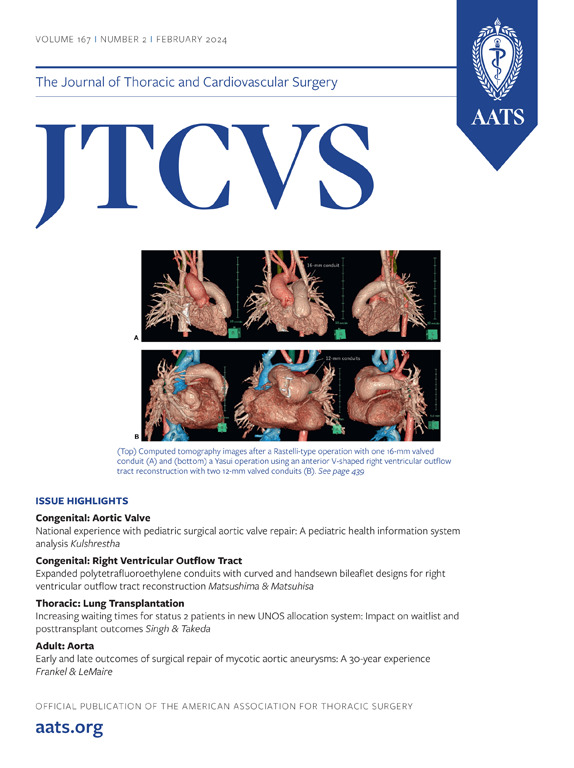Impact of permanent pacemaker for iatrogenic atrioventricular block on outcomes after congenital heart surgery
IF 4.9
1区 医学
Q1 CARDIAC & CARDIOVASCULAR SYSTEMS
Journal of Thoracic and Cardiovascular Surgery
Pub Date : 2025-02-01
DOI:10.1016/j.jtcvs.2024.08.026
引用次数: 0
Abstract
Objective
The need for permanent pacemaker (PPM) for iatrogenic atrioventricular block (AVB) after congenital heart surgery is approximately 1%. We aimed to evaluate the long-term outcomes of patients with PPM for iatrogenic AVB and compare them with patients with an optimal repair (trivial/no residual) Residual Lesion Score (RLS) Class 1 repair without PPM need.
Methods
We reviewed 183 patients discharged with PPM for iatrogenic AVB from 2011 to 2022. Patients who survived to discharge with >30 days of follow-up were matched 1:1 with a cohort of patients categorized as RLS Class 1 on the basis of fundamental diagnosis and primary procedure.
Results
Median age at PPM placement was 1.4 years (interquartile range, 4.3 months to 3.9 years). The cumulative incidence of moderate or greater ventricular dysfunction at 1 year and 5 years was 11% and 18% in patients with PPM, respectively, compared with 3% and 7% in patients categorized as RLS Class 1 (subdistribution hazard ratio, 2.6; 95% confidence interval, 1.2-6.1; P = .022). Independently, patients with PPM with hypoplastic left heart syndrome (P = .027) and who had undergone Society of Thoracic Surgeons-European Association for Cardio-Thoracic Surgery Mortality Category 5 procedures (P = .033) were at greater risk of ventricular dysfunction. Transplant-free survival at 1 year and 5 years was 94% and 89% in patients with PPM, respectively, compared with 98% and 97% in patients categorized as RLS Class 1 (P = .044). In addition, patients with PPM with palliated circulation had significantly lower transplant-free survival (P < .001).
Conclusions
Compared with patients with an optimal repair without PPM, patients with PPM for iatrogenic AVB are at greater risk of developing moderate or greater ventricular dysfunction and have lower transplant-free survival.
永久起搏器治疗先天性房室传导阻滞对先天性心脏手术后疗效的影响。
目的:先天性心脏手术后因先天性房室传导阻滞(AVB)而需要使用永久起搏器(PPM)的比例约为 1%。我们的目的是评估因先天性房室传导阻滞而使用永久起搏器的患者的长期预后,并将其与最佳修复(微不足道/无残留)-残留病灶评分(RLS)1 级修复而无需使用永久起搏器的患者进行比较:我们回顾了 2011 年至 2022 年期间因先天性房室传导阻滞而进行 PPM 出院的 183 例患者。根据基本诊断和主要手术,将出院后存活且随访时间超过 30 天的患者与 RLS Class-1 患者队列进行 1:1 匹配:置入PPM时的中位年龄为1.4岁(IQR:4.3个月-3.9岁)。1 年和 5 年后,PPM 患者中度或更严重心室功能障碍的累积发生率分别为 11% 和 18%,而 RLS Class-1 患者分别为 3% 和 7%(亚分布 HR,2.6;95% CI,1.2-6.1;P =0.022)。另外,患有左心发育不全综合征(P =0.027)和接受过 STAT 死亡率分类 5 手术(P =0.033)的 PPM 患者发生心室功能障碍的风险更高。PPM患者1年和5年的无移植存活率分别为94%和89%,而RLS 1级患者分别为98%和97%(P =0.044)。此外,有缓和循环的 PPM 患者的无移植生存率明显较低(P=0.044):与未进行 PPM 的最佳修复患者相比,因先天性 AVB 而进行 PPM 的患者出现中度或更严重心室功能障碍的风险更高,无移植生存率更低。
本文章由计算机程序翻译,如有差异,请以英文原文为准。
求助全文
约1分钟内获得全文
求助全文
来源期刊
CiteScore
11.20
自引率
10.00%
发文量
1079
审稿时长
68 days
期刊介绍:
The Journal of Thoracic and Cardiovascular Surgery presents original, peer-reviewed articles on diseases of the heart, great vessels, lungs and thorax with emphasis on surgical interventions. An official publication of The American Association for Thoracic Surgery and The Western Thoracic Surgical Association, the Journal focuses on techniques and developments in acquired cardiac surgery, congenital cardiac repair, thoracic procedures, heart and lung transplantation, mechanical circulatory support and other procedures.

 求助内容:
求助内容: 应助结果提醒方式:
应助结果提醒方式:


